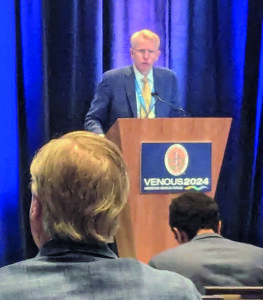
Evaluation of the safety and performance of a novel pharmaco-mechanical procedure for acute deep vein thrombosis (DVT) in two pigs demonstrated a significant reduction in thrombus burden and vessel wall preservation, data from in vivo testing reveals.
The SonoThrombectomy system (SonoVascular, Inc.) was tested on swine with thrombi in their iliac veins, with the study focused on establishing how the system—composed of an ultrasound catheter that delivers microbubbles to induce microbubble-mediated sonothrombolysis (MMS) alongside a mechanical thrombus retriever and aspiration sheath—would work in treating DVT without vessel trauma, blood loss, or a prolonged ICU stay.
Results were presented during the 2024 American Venous Forum (March 3–6) in Tampa, Florida, by William A. Marston, MD, professor of vascular surgery at the University of North Carolina Hospitals in Chapel Hill, North Carolina.
Safety was evaluated by a gross examination of the treated vessels following necropsy of the animals to identify intimal injury or disruption.
“We’ve all used ultrasound before,” Marston told the audience, “but this is a new method of using ultrasound, and the key is that it adds the function of microbubbles. These microbubbles are excited by the ultrasound waves to produce specific effects within the clot that you are addressing. This is a sub-megahertz frequency ultrasound catheter.”
Both pigs had fluoroscopies performed to evaluate the iliofemoral venous segments before and after thrombus creation. Complete vessel occlusion was achieved in all veins with a mean diameter of 11.0mm ±0.9mm and a mean clot length of 10.9cm ±1.0cm.
The thrombus was then crossed with a .018 wire and treatment was performed through SonoVascular’s 12F sheath with MMS.
“The procedure is a two-stage effort,” Marston said. “First, the sheath is inserted via the femoral common vein to the thrombus, which allows crossing with an open-ended guidewire. We then cross the thrombus, and pass the ultrasound catheter up and down to break up the clot with MMS and tPA [tissue plasminogen activator]. Second, retrieval is conducted using an associated basket. With this protocol, we advanced the ultrasound catheter one centimeter every 45 seconds. I think we can do it faster than that.”
Total time for the procedure averaged 17 minutes, with nearly complete clot treatment achieved, Marston said, concluding that the in vivo testing showed that the SonoThrombectomy System significantly reduced thrombus burden while preserving vessel walls. “This is a novel combination of ultrasound, microbubbles, and tPA, which we think will lead to the ability to do single-session sonothrombolysis,” he added. “We’re planning to move to in-human [testing] by the end of this year.”












